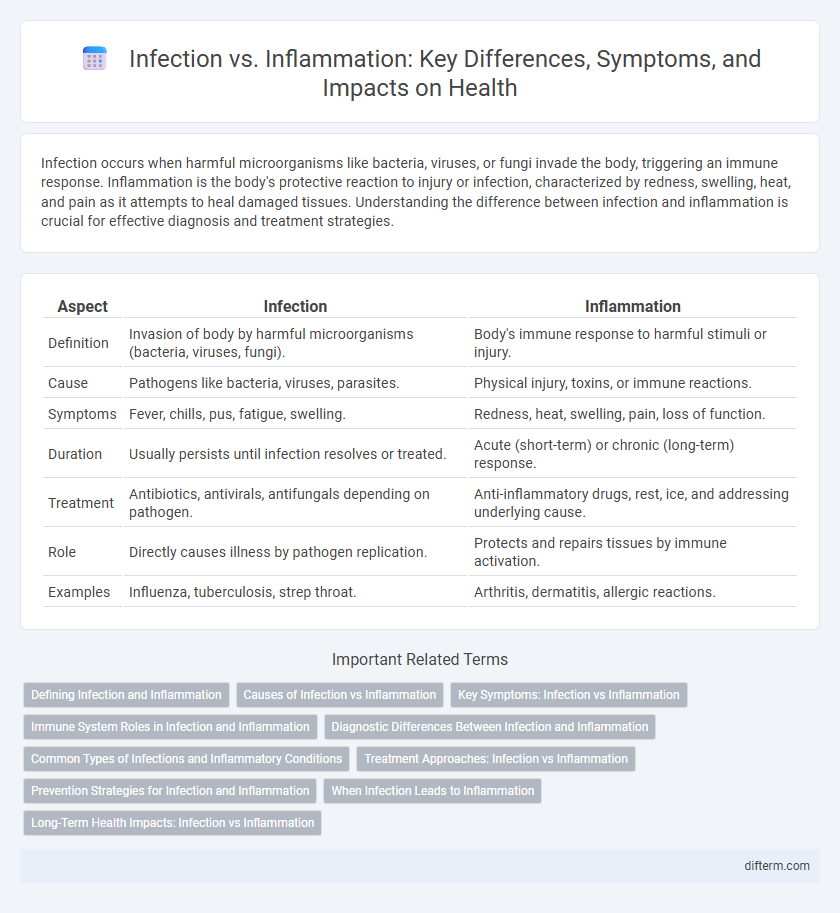Infection occurs when harmful microorganisms like bacteria, viruses, or fungi invade the body, triggering an immune response. Inflammation is the body's protective reaction to injury or infection, characterized by redness, swelling, heat, and pain as it attempts to heal damaged tissues. Understanding the difference between infection and inflammation is crucial for effective diagnosis and treatment strategies.
Table of Comparison
| Aspect | Infection | Inflammation |
|---|---|---|
| Definition | Invasion of body by harmful microorganisms (bacteria, viruses, fungi). | Body's immune response to harmful stimuli or injury. |
| Cause | Pathogens like bacteria, viruses, parasites. | Physical injury, toxins, or immune reactions. |
| Symptoms | Fever, chills, pus, fatigue, swelling. | Redness, heat, swelling, pain, loss of function. |
| Duration | Usually persists until infection resolves or treated. | Acute (short-term) or chronic (long-term) response. |
| Treatment | Antibiotics, antivirals, antifungals depending on pathogen. | Anti-inflammatory drugs, rest, ice, and addressing underlying cause. |
| Role | Directly causes illness by pathogen replication. | Protects and repairs tissues by immune activation. |
| Examples | Influenza, tuberculosis, strep throat. | Arthritis, dermatitis, allergic reactions. |
Defining Infection and Inflammation
Infection occurs when harmful microorganisms such as bacteria, viruses, fungi, or parasites invade the body, causing tissue damage and triggering an immune response. Inflammation is the body's complex biological reaction to harmful stimuli, including infections, characterized by redness, swelling, heat, pain, and loss of function. While infection specifically involves the presence of pathogens, inflammation is a broader immune process that can occur with or without infection.
Causes of Infection vs Inflammation
Infections are caused by pathogenic microorganisms such as bacteria, viruses, fungi, or parasites invading the body and multiplying, leading to tissue damage and illness. Inflammation, however, is the body's immune response triggered by various factors including infections, physical injuries, chemical irritants, or autoimmune reactions where the immune system attacks healthy tissue. While infection involves the presence of harmful microbes, inflammation is a complex biological process aimed at eliminating harmful stimuli and initiating healing.
Key Symptoms: Infection vs Inflammation
Infections typically present with symptoms such as fever, localized pain, swelling, redness, and pus formation due to the presence of pathogens like bacteria, viruses, or fungi. Inflammation manifests with redness, heat, swelling, pain, and loss of function as a response to tissue injury or immune reaction without necessarily involving an infectious agent. Distinguishing key symptoms like fever and pus indicates infection, whereas inflammation is characterized by sterile swelling and pain without microbial invasion.
Immune System Roles in Infection and Inflammation
The immune system defends the body against infections by identifying and eliminating pathogens such as bacteria, viruses, and fungi. Inflammation is a protective response triggered by immune cells to remove harmful stimuli and initiate tissue repair, characterized by redness, heat, swelling, and pain. While infection involves the presence and proliferation of pathogens, inflammation can occur independently as the immune system responds to various forms of cellular damage or irritants.
Diagnostic Differences Between Infection and Inflammation
Distinguishing between infection and inflammation requires analyzing clinical symptoms alongside laboratory tests such as complete blood count (CBC), C-reactive protein (CRP), and procalcitonin levels, which tend to be elevated in infections. Imaging techniques, including ultrasound, MRI, or CT scans, help identify localized infections or inflammatory processes by revealing abscess formation or tissue swelling. Microbiological cultures and molecular assays provide definitive evidence of pathogenic presence, differentiating infectious causes from sterile inflammatory responses.
Common Types of Infections and Inflammatory Conditions
Bacterial infections such as strep throat and urinary tract infections frequently affect the respiratory and urinary systems, while viral infections like influenza and COVID-19 target the respiratory tract. Common inflammatory conditions include rheumatoid arthritis, characterized by chronic joint inflammation, and inflammatory bowel diseases such as Crohn's disease and ulcerative colitis, which cause persistent inflammation in the digestive tract. Understanding these distinct types helps guide appropriate treatment strategies based on whether the underlying cause is infectious or autoimmune.
Treatment Approaches: Infection vs Inflammation
Treatment approaches for infection primarily involve targeting the causative pathogens with antibiotics, antivirals, or antifungals to eradicate the infectious agents. Inflammation treatment focuses on reducing tissue swelling and immune response using nonsteroidal anti-inflammatory drugs (NSAIDs), corticosteroids, or immunosuppressants. Accurate diagnosis is critical to avoid unnecessary antibiotic use in inflammatory conditions where infection is not present.
Prevention Strategies for Infection and Inflammation
Effective prevention strategies for infection include consistent hand hygiene, vaccination, and avoiding close contact with infected individuals. To prevent inflammation, maintaining a balanced diet rich in antioxidants, regular physical activity, and managing stress levels are crucial. Early detection and timely intervention also reduce the risk of chronic inflammatory conditions and infection-related complications.
When Infection Leads to Inflammation
Infection occurs when pathogenic microorganisms such as bacteria, viruses, or fungi invade the body, triggering an immune response. This immune response often results in inflammation, characterized by redness, swelling, heat, and pain, as the body attempts to isolate and eliminate the infectious agents. Persistent or severe infections can cause chronic inflammation, potentially leading to tissue damage and contributing to various health complications.
Long-Term Health Impacts: Infection vs Inflammation
Chronic infections can lead to persistent immune activation, increasing the risk of tissue damage and contributing to diseases such as cancer, cardiovascular conditions, and autoimmune disorders. Inflammation, when prolonged, causes cellular stress and fibrosis, impairing organ function and heightening the likelihood of chronic illnesses like arthritis, diabetes, and neurodegenerative diseases. Both infection-driven and inflammation-driven processes significantly affect long-term health by disrupting homeostasis and promoting systemic complications.
Infection vs Inflammation Infographic

 difterm.com
difterm.com